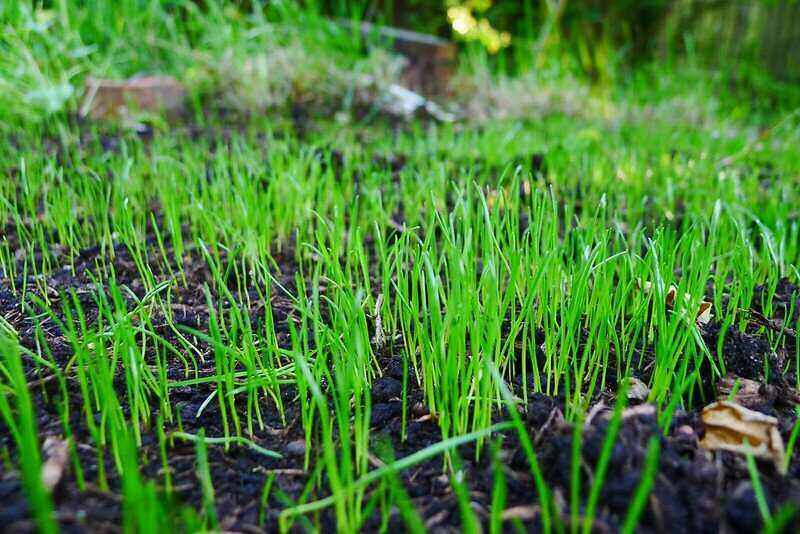
Lawn care terminology can seem overwhelming at times, but overseeding is a very simple process. Overseeding is simply planting new seed on top of your existing lawn. It is a routine part of lawn maintenance that keeps lawns thick and healthy year-round.
Bring new life to your lawn
If you have ever spread new seed over your grass, you’ve overseeded your lawn. This is not the same as starting a lawn from scratch. In that case, you are removing existing grass and reseeding or starting with a newly graded property that doesn’t yet have turfgrass. Overseeding takes a lawn with bare spots or thinning grass and brings new life, health, and beauty to it by laying down more grass seed that will germinate and grow.
Sometimes you need to overseed
Healthy lawns take work, and sometimes they fail despite our best efforts. Adverse weather conditions, competition from weeds and tree roots, and excessive shade can cause grass to die. Improper mowing and drainage and a lack or excess of nutrients may adversely affect your grass, as well.
When any of these factors impact your lawn, sometimes bare patches and disease occur. To prevent further damage, you have to overseed to get healthy, new grass to grow. Remember, a full, healthy lawn with deep roots is one of the best ways to prevent weeds and assist lawns during times of drought or weather stress.
Time it right
When should you overseed? It depends on where you live.
For homeowners with cool-season grass, the best time to overseed is late summer through early fall. You can seed in early spring if necessary. Warm-season grasses should be sown from late spring through early summer.

Popular cool-season grasses include tall fescue, perennial ryegrass, Kentucky bluegrass, and fine fescue. Warm-season grasses include Zoysiagrass, St. Augustinegrass, centipedegrass, bermudagrass, and bahiagrass.
Do you live in the Transition Zone? You can use either warm- or cool-season varieties. Check with your local Cooperative Extension Service or lawn care professional for more information on the best grass for your soil and weather conditions and the best time to overseed.
Pro Tip: If you want your warm-season lawn to have winter color, you can overseed in early fall with cool-season grass. The combination keeps your lawn green and lush year-round.
Simple steps to overseed a lawn
Most professionals who overseed will do more than use a spreader to scatter seed throughout the lawn. If you want the best results, you’ve got to do a little bit of preparation.
1. Mow the lawn
- Mow it down to 1 ½ inches to 2 inches
2. Prepare the lawn
- Dethatch: Rent a dethatching machine to remove excess thatch. Thatch is a layer of dead and living material (leaves, stems, roots) between the soil and the living grass above it.
- Go over the lawn with a core aerator, which is a machine that pulls plugs from the soil. This helps to reduce soil compaction by allowing water and air to flow more freely. It also will remove some thatch, but not as much as a dethatching machine
- Apply compost
- Fertilize, if needed
3. Spread the seed: Cast the seed with a spreader. Use the backside of a rake to spread it around evenly.
4. Water regularly: Water daily — or as often as twice daily — until your grass seedlings are as tall as the existing lawn. Keep them moist, but not soggy. After that, only water about two times each week to encourage deep root growth.
5. Enjoy your lush, green lawn
Pro Tip: For best results, take a soil sample to your local Cooperative Extension office or buy an at-home soil test to determine your lawn’s nutrient profile before you fertilize. If you’re using your state’s Cooperative Extension Service, you may need to allow a few weeks of processing time.
Provide proper care

The new, young grass should be at least 1 to 2 inches tall before you get out the lawn mower again. Others say wait three to four weeks and set your mower on the highest setting. It’s also a good idea to keep people and pets off the grass for those first three to four weeks. When you start to mow again, remember to follow the one-third rule — never cut off more than one-third of the height of the grass at one time.
Overseeding helps you get that optimal lawn
Overseeding is a simple concept that can make a big impact on the health and fullness of your lawn. Choosing an appropriate seed variety, timing the overseeding right, and putting in a little elbow grease will help you reap the rewards all season long.
For more in-depth information, see our article, “Four Steps to Overseed a Lawn.”
If you would prefer to have a professional overseed your yard, you can find a local pro near you to help with a variety of lawn care and landscaping projects.
Main Photo Credit: Shutterstock